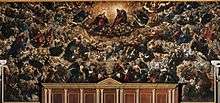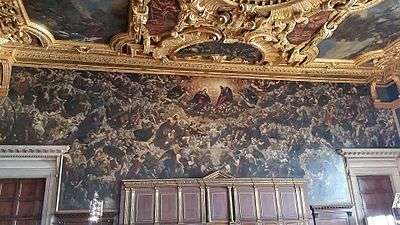Il Paradiso
Il Paradiso is a massive (22 x 7 meters) oil painting on canvas that dominates the main hall of the Doge's Palace in Venice.

Of it, John Ruskin said, "I have no hesitation in asserting this picture to be by far the most precious work of art of any kind whatsoever, now existing in the world."[1]
History
In 1577, a fire destroyed part of the Doge's Palace, including a 14th-century fresco by Guariento depicting the Coronation of the Virgin. A competition to replace the damaged painting was held.[2] The contestants submitted highly varied sketches. Veronese was chosen, but died before the work began and Tintoretto replaced him. Tintoretto presented two sketches, both unlike the final version; this was his last major work and it was completed mostly by his workshop under the direction of his son, Domenico.[2] This gigantic canvas—one of the world's largest paintings, almost 25 metres (82 ft) long—was painted in sections, in the large main hall of the Scuola della Misericordia.
Painting
The Virgin Interceding with Christ portrays the scene surmounted by the dove of the Holy Spirit and raised upon a dense semicircular rank of cherubim and seraphim. The reference to the Annunciation that had figured in the previous fresco was present: the Archangel Gabriel is shown holding out a lily to Mary, depicted with a halo of 7 stars. The divine light emanates not from the dove of the Holy Spirit but from the figure of Christ the Judge, shown holding a globe surmounted by a cross; to his right stands the Archangel Michael holding out the scales of justice. The order of the celestial hierarchy is respected: the evangelists appear in a semi-circle immediately beneath the main scene, with the saints aligned in the same order in which they figure in church litanies.
Historical references include the portrayal of Justina, patron saint of Padua (whose celebration day is October 7, the date of the Battle of Lepanto).
From the center of the stage a path of light opens up towards the Empyrean, allowing the souls of the Just to ascend (with the assistance of angels) and God's Grace to descend upon the Doge. At the center of this path is the radiant figure of a semi-veiled Archangel. The composition is crowded with around 500 figures, depicted in detail.
Gallery
References
| Wikimedia Commons has media related to Paradise by Tintoretto (Palazzo Ducale). |
- Ruskin, John, Aratra Pentelici, Seven Lectures on the Elements of Sculpture. Given at the University of Oxford, 1870; Lecture VII: "The Relation Between Michael Angelo and Tintoret"
- "Louvre - Communiqué de presse" (PDF). Retrieved 17 April 2020.

.jpg)
